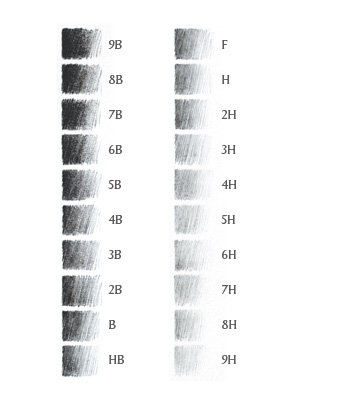 |
| Pencil Grading Chart |
Pencil cores are generally made of
graphite mixed with a
clay binder which creates easily erased grey or black marks.
Graphite pencils are used for both writing and drawing which provides a durable mark, resistant to moisture, ultraviolet radiation, and aging.
Pencils come with either
numbers or
letters on them. From the image right, we can see that the letter
B signifies the
blackness of the pencil, the letter
H signifies the
hardness, and the letter
F stands for '
fine.' In the United States, we use a different system using numbers to identify pencil hardness, ranging from #1 to #4. A #2 pencil, all to familiar to those that grew up in the US is the equivalent to the European
HB.
The
B's get darker and as you get to
9B they become more and more charcoal like.
B's are tougher to erase than
H leads so remember what type of sketch or drawing you are doing. Quick sketches using a
B lead are very vibrant with more emotion then with an
H lead. H leads are harder and make then easier to erase. Just remember that the harder you press down, they will indent the paper making them tough to erase, just watch the amount of pressure you use. I tend to use an H lead, such as a
2H,
4H, or even
6H to start my drawings, sketch it out, and use an
HB or a
B lead to go over it, just remember
B leads are tougher to erase. You can always use as many leads as you want and layer over it. You can even use the leads to color your drawing or sketch using the leads. A
4H lead for example is very grey, I sometimes use this for metal, while an
HB can be used for shadows with a
6B can be used for deep shadows or whatever you want to be black. Look at the image above again and you will see what I mean.
I recommend buying a cheap
electric pencil sharpener and a few
pencil sharpeners to make sketching easier. A scrap piece of paper can also work well to help keep the ideal edge or point on your pencil. Using conventional leads to draft can be difficult, but not impossible. It is better to use a
lead holder and
sharpener, as the leads are much sharper which gives you a cleaner, sharper drawing. You can also use
lead holders for sketching and drawing.
Mechanical pencils can also be used for drafting, however I prefer to use them to do homework as they don't need sharpening.
Beginners If you are just starting to draw, you might one to pick up just a few pencils to get a feel for them. You don't necessarily need pencils of each type, opt to get a few:
4B,
2B,
HB,
2H,
4H will suffice and will save you a little money. A combo pack or starter set gets you the best bang for your buck, just be sure you check which leads they come with. As an architecture student, you probably want ones in the middle (
6B through
4H), though a
9B you might like for some quick sketches now and again.
 |
| Staedtler Starter Set |
Quality The last thing that you should be aware of is pencil quality. If you buy pencils that are not high quality, the leads are more prone to break with a wood casing of questionable quality. I have been drawing for about 30 years and I recommend using
Staedtler pencils, they are my favorite brand. However,
Koh-i-Noor,
Faber-Castell,
Derwent, and
Turquoise are all my second choices.
General pencils I found not too be too great however they make great
charcoal pencils. To start, buy a pencil set of some sort and play with them. Once you figure out which leads you prefer, you can always buy replacement pencils later as you use them up.



